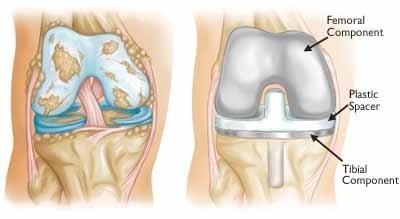
Patients whose arthritis or knee condition is severe and
affects the whole knee, a total knee replacement may be the most suitable
procedure to relieve pain and maintain movement.
In total knee replacement, both inner and outer articular
surfaces on the femur (thigh bone) and on the tibia (shin bone) are
replaced. The prosthesis (replacement
components) include a replacement for the anterior cruciate ligament to help
maintain normal knee function. The
operation may or may not include the patella (knee cap).
The operation usually involves four to five nights in
hospital. Using advanced, minimally
invasive techniques, patients are often standing on the day following the
operation and can begin physiotherapy immediately, with regular sessions each
day.
Range of movement following a knee replacement is usually
improved, but the operation is primarily performed to remove pain and maintain
movement. However, as pain can restrict
movement before a replacement operation, patients often find the range of
movement increases significantly.
Patients can improve the outcome from a knee replacement
operation by starting physiotherapy before the operation. This can improve movement, strengthen muscles
and increase flexibility – all of which can lead to a faster and fuller
recovery post surgery.